

Understanding XML Schema. Aaron Skonnard DevelopMentor March 2003 Applies to: Type systems XML Schema definition language (XSD) Web Services development Summary: XML Schema is poised to play a central role in the future of XML processing, especially in Web services where it serves as one of the fundamental pillars that higher levels of abstraction are built upon.
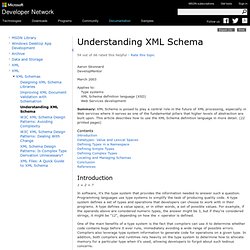
Xml - Getting attribute using XPath. Simple Object Access Protocol (SOAP) 1.1. W3C Note 08 May 2000 This version: Latest version: Authors (alphabetically): Don Box, DevelopMentor David Ehnebuske, IBM Gopal Kakivaya, Microsoft Andrew Layman, Microsoft Noah Mendelsohn, Lotus Development Corp.
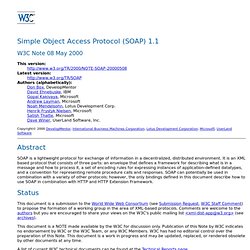
Henrik Frystyk Nielsen, Microsoft Satish Thatte, Microsoft Dave Winer, UserLand Software, Inc. Copyright© 2000 DevelopMentor, International Business Machines Corporation, Lotus Development Corporation, Microsoft, UserLand Software SOAP is a lightweight protocol for exchange of information in a decentralized, distributed environment. This document is a submission to the World Wide Web Consortium (see Submission Request, W3C Staff Comment) to propose the formation of a working group in the area of XML-based protocols. This document is a NOTE made available by the W3C for discussion only.
A list of current W3C technical documents can be found at the Technical Reports page. 1. SOAP consists of three parts: Web Services Policy 1.5 - Attachment. This section describes a mechanism for associating policy expressions with Web service constructs in WSDL 1.1 [WSDL 1.1].
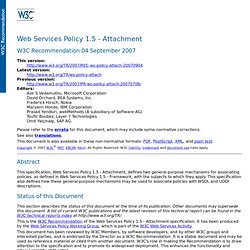
The mechanism consists of: WSDL 1.1 disallows the use of extensibility elements on certain elements and the use of extensibility attributes on others. However, the WS-I Basic Profile 1.1 [BP 1.1] overrules this restriction and allows element extensibility everywhere. Therefore, when attaching a reference directly to the WSDL element the policy reference SHOULD be attached using wsp:PolicyReference as child element unless it is absolutely necessary to maintain the original WSDL 1.1 restriction, in which case the @wsp:PolicyURIs attribute MAY be used for the following WSDL elements: If it is necessary to include the actual policy expressions within the WSDL description itself, it is RECOMMENDED that their wsp:Policy elements be included as children of the wsdl11:definition element, and referenced using the mechanisms just described.
XSLT Chapter 8: Advanced Pattern Matching. XPath Examples. XPATH: Retrieve Value without namespace prefixes. SQL Server XML Questions You Were Too Shy To Ask. Sometimes, XML seems a bewildering convention that offers solutions to problems that the average database user doesn't have.
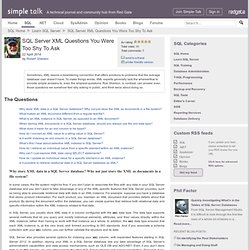
To make things worse, XML experts generally lack the wherewithal to provide simple answers to even the simplest questions. Rob Sheldon, in contrast, can answer even those questions we somehow feel silly asking in public, and think twice about doing so. Why store XML data in a SQL Server database? Why not just store the XML as documents in a file system? In some cases, the file system might be fine, if you don’t plan to associate the files with any data in your SQL Server database and you don’t want to take advantage of any of the XML-specific features that SQL Server provides, such as being able to associate relational data with data in an XML instance.
In SQL Server, you usually store XML data in a column configured with the xml data type. Applying an XSL Transformation (SQLXML Managed Classes) In this example, an SQL query is executed against the AdventureWorks database.
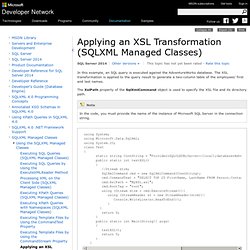
The XSL transformation is applied to the query result to generate a two-column table of the employees' first and last names. The XslPath property of the SqlXmlCommand object is used to specify the XSL file and its directory path. using System; using Microsoft.Data.SqlXml; using System.IO; class Test { static string ConnString = "Provider=SQLOLEDB;Server=(local);database=AdventureWorks;Integrated Security=SSPI"; public static int testXSL() { //Stream strm; SqlXmlCommand cmd = new SqlXmlCommand(ConnString); cmd.CommandText = "SELECT TOP 20 FirstName, LastName FROM Person.Contact FOR XML AUTO"; cmd.XslPath = "MyXSL.xsl"; cmd.RootTag = "root"; using (Stream strm = cmd.ExecuteStream()){ using (StreamReader sr = new StreamReader(strm)){ Console.WriteLine(sr.ReadToEnd()); } } return 0; } public static int Main(String[] args) { testXSL(); return 0; } } This is the XSL style sheet you can use to test the application:
High speed XSLT to convert from XML to CSV. XML to CSV Using XSLT Stack Overflow. XML to CSV Using XSLT. Steve Wellens - Debugging XML Transforms (XSLT) with Visual Studio. XSLT stands for Extensible Stylesheet Language Transformations.
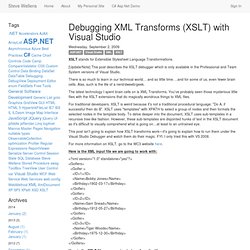
[Update/Note] This post describes the XSLT debugger which is only available in the Professional and Team System versions of Visual Studio. There is so much to learn in our technical world… and so little time….and for some of us, even fewer brain cells. Alas, such is the life of a nerd/dweeb/geek. The latest technology I spent brain cells on is XML Transforms. You've probably seen those mysterious little files with the XSLT extensions that do magically wondrous things to XML files. XSL Transformations (XSLT) Version 2.1. XSL Transformations (XSLT) Version 3.0. XSLT. XSLT (Extensible Stylesheet Language Transformations) is a language for transforming XML documents into other XML documents,[1] or other objects such as HTML for web pages, plain text or into XSL Formatting Objects which can then be converted to PDF, PostScript and PNG.[2] The original document is not changed; rather, a new document is created based on the content of an existing one.[3] Typically, input documents are XML files, but anything from which the processor can build an XQuery and XPath Data Model can be used, for example relational database tables, or geographical information systems.[1]
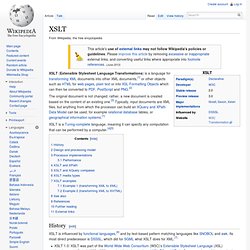
XSLT Tutorial. ESB in Practice. Introduction There are many ways to implement an ESB with IBM's products and other middleware vendor's products.
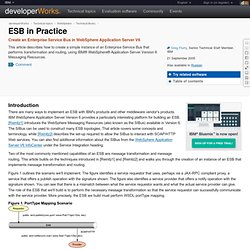
IBM WebSphere Application Server Version 6 provides a particularly interesting platform for building an ESB. [Reinitz1] introduces the WebSphere Messaging Resources (also known as the SIBus) available in Version 6. The SIBus can be used to construct many ESB topologies. That article covers some concepts and terminology, while [Reinitz2] describes the set-up required to allow the SIBus to interact with SOAP/HTTP Web services.
Two of the most commonly mentioned capabilities of an ESB are message transformation and message routing. Figure 1 outlines the scenario we'll implement. Figure 1. XSLT Tutorial. XSLT facts. Undefined Interesting facts about XSLT In this page, I am compiling some interesting facts that I discovered during the course of my learning the XSLT language.

Java API for XML Web Services.
XML Schema Date/Time Datatypes. Introduction to the WSDL Editor.